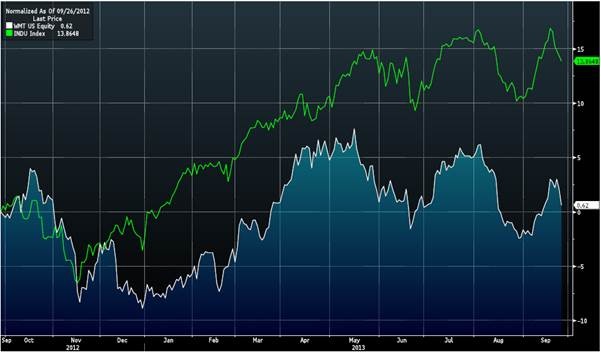Wal-Mart's pile of lessons for Australian retailers
In a sign of things to come, Wal-Mart — the world's largest retailer — is battling rising inventory levels in a classic case of a retailer being overzealous about the willingness of consumers to spend.
Current justifications for share price movements across the globe are tapering and the US debt ceiling. Unfortunately for Wal-Mart, neither of these apply to the 1.45 per cent decline as they now find themselves facing critical problems with their business and operating environment.
It was only last month that Wal-Mart flagged rising inventories to be of concern in their second quarter earnings report. To remedy the situation, Wal-Mart told suppliers it will cut orders.
Domestic retailers and consumers have been feeling the pinch, but it is evident we are not alone. The inventory problems facing Wal-Mart are a telling indication of the problems facing the US middle class, which is Wal-Mart’s primary market.
The US economy has experienced excessive monetary stimulus measures to keep long-term interest rates low and improve employment. But it hasn’t been enough to keep the retail sector chugging along.
Domestically, we face a different set of problems: a higher currency and, until only recently, weak business and consumer confidence. But Wal-Mart’s problems could be the writing on the wall for the future of domestic retailers.
Wesfarmers brand Target knows all too well what it is to be a struggling retailer. Target’s total sales of $3.7 billion were only 1.7 per cent down on the previous year. For the year, earnings fell a massive 45 per cent. Price deflation and strong competition were factors in its overall poor performance.
In a bid to reduce inventories, the decision was made to undertake high levels of clearance activity. With a weaker currency, domestic retailers won’t be able to discount as aggressively and remain profitable. In an already stretched operating environment, inventory management will be the difference between profitability and resentful shareholders.
Wal-Mart investors would be disenchanted with the share price performance over the past twelve months, having only gained a meagre 0.62 per cent (white line). In comparison, the Dow Jones index has gained 13.8 per cent (green line).

Taking Wal-Mart’s share price as a forward measure of about the state of the economy, the future for Wal-Mart and retailers alike doesn’t look compelling.
















